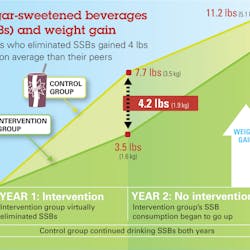In response to the New England Journal of Medicine, which includes a number of studies and opinion pieces focused exclusively on sugar-sweetened beverages, the American Beverage Association issued the following statement:
“Obesity is a serious and complex public health issue facing our nation and the rest of the world, and we all must work together to solve it. We know, and science supports, that obesity is not uniquely caused by any single food or beverage. Thus, studies and opinion pieces that focus solely on sugar-sweetened beverages, or any other single source of calories, do nothing meaningful to help address this serious issue.
The fact remains: sugar-sweetened beverages are not driving obesity. By every measure, sugar-sweetened beverages play a small and declining role in the American diet:
- While Americans consume about 617 more calories today than they did in 1970, more than 90 percent of those incremental calories come from sources other than beverages.
- Sugar-sweetened beverages contribute about 7 percent of the calories in the average American’s diet.
- Caloric intake from sugar-sweetened beverages declined by more than 20 percent between 2001 and 2010, yet obesity rates continued to rise.
- The average number of calories per beverage serving is down 23 percent since 1998 and about 45 percent of all non-alcoholic beverages purchased today have zero calories.
- Forty-eight percent of overweight and obese individuals drink no sugar-sweetened beverages.
Importantly, the beverage industry is doing its part to help consumers make informed choices that are right for them. We’re taking common-sense steps that are having a meaningful and lasting impact:
- We’re providing more beverage options than ever before, with a wide array of calorie and portion size options. According to Beverage Marketing Corp. data, the average number of calories per beverage serving is down 23 percent since 1998, and about 45 percent of all non-alcoholic beverages purchased today have zero calories.
- Under a Global Policy on Marketing to Children, we voluntarily agreed to advertise only water, juice and milk-based drinks to any audience that is comprised predominantly of children under 12. Our members also follow the guidelines of the Children’s Advertising Review Unit (CARU) of the Council of Better Business Bureaus, the self-regulatory body for children’s advertising;
- By working with President Clinton on national School Beverage Guidelines, we’ve removed full-calorie soft drinks from all K-12 schools and replaced them with more lower-calorie, smaller-portion choices in age-appropriate portion sizes, driving a 90 percent reduction in beverage calories shipped to schools between 2004 and the end of the 2009-2010 school year.
- We’re supporting First Lady Michelle Obama’s ‘Let’s Move!’ campaign with our Clear on Calories initiative to display clear calorie information on the front of every bottle, can and pack we produce.”






